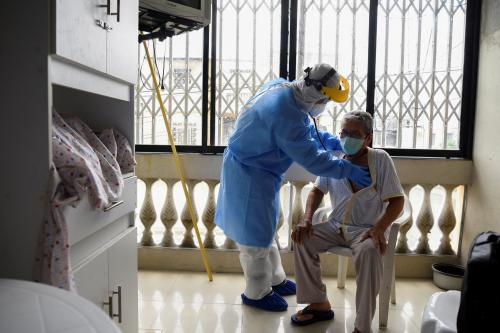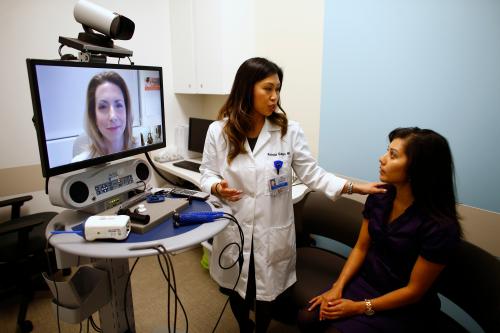Health care languishes in data dissonance. A fundamental imbalance between collection and use persists across systems and geopolitical boundaries. Data collection has been an all-consuming effort with good intent but insufficient results in turning data into action. After a strong decade, the sentiment is that the data is inconsistent, messy, and untrustworthy. The most advanced health systems in the world remain confused by what they’ve amassed: reams of data without a clear path toward impact. Artificial intelligence (AI) can see through the murk, clear away the noise, and find meaning in existing data beyond the capacity of any human(s) or other technology.
AI is a term for technologies or machines that have the capability to adapt and learn. This is the fundamental meaning of being data-driven, to be able to take measure of available data and perform an action or change one’s mind. Machine Learning is at the heart of AI—teaching machines to learn from data, rather than requiring hard-coded rules (as did machines of the past).
No domain is more deserving of meaningful AI than health care. Health care is arguably the most complex industry on earth—operating at the nexus of evolving science, business, politics, and mercurial human behavior. These influences push and pull in perpetual contradiction.
Health care—specifically psychology—is the mother of machine learning. In 1949, Dr. Donald Hebb created a model of brain cell interactions, or “synaptic plasticity,” that forms the ancestral architecture of the artificial neural networks that pervade AI today. Math to explain human behavior became mathematics to mimic and transcend human intellect. AI is now at the precipice of a return to the health care domain.
To achieve impact at scale, machine learning must be deployed in the most and least advanced health systems in the world. Any decent technology should remain resilient outside the walls of academia and the pristine data environments of tech giants. AI can learn from many dimensions of data—photographs, natural language, tabular data, satellite imagery—and can adapt, learning from the data that’s available. The ability to adapt is what defines AI. AI at its best is designed to solve complex problems—not wardrobe preferences. Now is the time to bring AI to health care.
COVID-19 is the greatest global crisis of our time: an immediate health challenge and a challenge of yet unknown duration on the economic and psychological well-being of our society. The lack of data-driven decisionmaking and the absence of adaptive and predictive technology have prolonged and exacerbated the toll of COVID-19. It will be the adoption of these technologies that helps us to rebuild health and society. AI has already forged new solutions for the COVID-19 response and the accelerated evolution of health care. Machine learning models from MIT for transmission rates have generated impressive precision—in some cases reducing error rates by 70 percent. Researchers at Mount Sanai in New York City have demonstrated the ability to reduce testing from two days to near instant by combining AI models with chest computed tomography (CT), clinical symptoms, exposure history, and laboratory testing—reducing error of false negatives. AI models—unlike test kits—can travel instantly to new users, are not limited in production, and do not require additional training and complementary equipment.
Adoption of AI must be done in concert with existing systems and solutions. Epidemiological models in concert with AI technology adapt and learn in real time—integrating new data to help explain ancillary elements of health outcomes. However, collaboration between epidemiology and machine learning has been limited. The prominent epidemiological models are not integrating dynamic machine learning. Without machine learning, epidemiological models are updated weekly, losing precious time and rendering wildly inaccurate predictions that have been widely criticized. Human bias is writ large in these models—variable importance is determined by experts rather than learned and derived from the data.
AI models can derive implicit and explicit features from available data to increase the precision and adaptability of transmission predictions. Organizations like Metabiota have mapped thousands of pandemics to generate a model for risk. Existing electronic information systems (EIS) hold valuable historical health data when they are available—both pandemic models and EIS are excellent sources for AI engines targeted at optimization of pandemic response at scale.
Optimization—in terms of tuning a health system to produce a maximum value (life expectancy, for example) or minimum value (cost of care) is the end goal of AI for health. By looking forward into the future and predicting demand, constraints, and behavior, AI can buy time. Time to prepare and ensure that resources are deployed to maximize the impact of every unit: financial, human, or commodity. Most models look backwards—like driving a car by only looking at the rearview mirror—yet they are asked to make decisions for the future. It’s Sisyphean to ask legacy analytics to prepare for tomorrow based on what is often a distant (months, weeks, or days at best) past of linear data inputs. Optimization through machine learning and AI technologies brings the prescience to data-driven decisions and actions required for impact. Machine-learning-optimized laboratory testing at MIT has accelerated discovery of new antibiotics previously considered unachievable due to the significant time and financial investment.
At the health system level, action is being accelerated through direct engagement with those at the front lines. Human-in- the-loop (HIL) machine learning (ML) is the process of receiving data-rich insights from people, analyzing them in real time, and sharing recommendations back. HIL ML is the science of teaching machines to learn directly from human input. In Mozambique and slated to expand to Sierra Leone, macro-eyes technology is learning directly from front-line health workers—the foremost experts on the conditions for care in the communities they serve. This becomes a virtuous cycle of high-value data, timely insights, and accelerated engagement at the point of care. Facility-level precision from HIL ML in Sierra Leone will complement AI optimization engines being deployed to probabilistically estimate the availability of essential resources at facilities across the country, account for new resources constraints, and recommend distribution of resources.
COVID-19 has highlighted the need for rapid connection between data analytics and the front lines of care. That connection still does not exist at scale. The result: Authorities must decipher a myriad of models estimating COVID-19-related transmissions and deaths in the near past and estimations for the future that don’t build knowledge or data from the ground up. This fundamental disconnect has hindered health care for decades—those who deliver the care have the least voice in how care is delivered. It can be resolved with minimal disruption using HIL ML to engage an educated and impassioned community of health workers.
AI in health has been successful but far too limited. The inability to trust what we don’t fully understand, misrepresentation of AI expertise by early participants, and the financial fortitude of the global funding mechanisms remain barriers to adoption. AI can—and will—exponentially improve the delivery of care around the world. The data and the data infrastructure are ready and the time for bold investment is now. Investment must move away from pilots with insufficient horizon and commitment. AI at scale—as bold innovations of the past—will only be possible with a committed corpus of financiers, policymakers, and implementing partners dedicating resources to AI experts solving problems at the foundations of health.
But we must proceed with caution. The world is replete with AI “solutions” and experts purporting to save the planet. Be critical—there is very little real AI talent, and even fewer teams have the chops to deploy AI in the real world. The AI scientists of the future will not look like those of the recent past. The software engineers turned “AI experts” who brought AI to the digital world in Silicon Valley, and academics building models in protected vaults, will be usurped by adaptive, scrappy, problemsolving engineers using AI to make change in the communities they care about: deploying in the physical world meaningful solutions to complex problems. What is more meaningful than health?
The Brookings Institution is committed to quality, independence, and impact.
We are supported by a diverse array of funders. In line with our values and policies, each Brookings publication represents the sole views of its author(s).







Commentary
AI: The complex solution to simplify health care
June 16, 2020